The Mitsunobu reaction is a versatile and powerful tool in organic synthesis, allowing for the functionalization of alcohols with a wide range of nucleophiles. This reaction is particularly useful for the preparation of PEG-based conjugates, as it can be carried out in a quantitative manner without compromising the integrity of the PEG backbone.
Understanding the Mitsunobu Mechanism
The Mitsunobu reaction typically involves the use of triphenylphosphine (PPh3) and diethyl azodicarboxylate (DEAD) as the key reagents, along with an alcohol and a nucleophile. The reaction proceeds through the formation of a phosphonium intermediate, which activates the alcohol as a leaving group and facilitates substitution by the nucleophile. This process occurs with clean inversion of stereochemistry, making the Mitsunobu reaction a valuable method for the inversion of stereogenic centers in natural product synthesis.
The mechanism of the Mitsunobu reaction can be summarized as follows:
- Reaction of PPh3 and DEAD to form a phosphonium intermediate.
- Activation of the alcohol by the phosphonium intermediate, forming an alkoxyphosphonium ion.
- Nucleophilic substitution of the alkoxyphosphonium ion by the nucleophile, with inversion of stereochemistry.
- Elimination of the phosphine oxide byproduct, completing the reaction.
The specific steps of the Mitsunobu mechanism can be represented by the following equations:
PPh3 + DEAD → PPh3=N-N-CO2Et
PPh3=N-N-CO2Et + ROH → [PPh3-O-R]+ + N2 + EtO2C-N=N-CO2Et
[PPh3-O-R]+ + Nu- → R-Nu + PPh3=O
Scope and Limitations of the Mitsunobu Reaction

The Mitsunobu reaction is a versatile tool that can be used to functionalize a wide range of alcohols with various nucleophiles, including azides, aldehydes, primary amines, thiols, and N-oxymaleimide. The reaction typically proceeds with high yields and excellent conversion rates, making it a valuable technique in organic synthesis.
However, the Mitsunobu reaction is not without its limitations. Some key considerations include:
- Substrate Scope: The Mitsunobu reaction is most effective with primary and secondary alcohols, while tertiary alcohols can be more challenging substrates.
- Nucleophile Scope: The choice of nucleophile is crucial, as some nucleophiles (e.g., carboxylic acids, phenols) may undergo side reactions or compete with the desired substitution.
- Stereochemistry: The Mitsunobu reaction proceeds with inversion of stereochemistry, which can be advantageous for certain synthetic transformations but may be a limitation in other cases.
- Byproduct Removal: The phosphine oxide byproduct generated during the reaction can be difficult to remove, requiring careful purification steps.
Recent Advances in the Mitsunobu Reaction
Researchers have been actively exploring ways to address the limitations of the Mitsunobu reaction and expand its utility. Some notable advancements include:
-
Bifunctional Reagents: The development of separation-friendly bifunctional reagents, such as 4-(diphenylphosphino)benzoic acid, which can serve as both a reductant and a pronucleophile, has improved the efficiency and practicality of the Mitsunobu reaction.
-
Modified Mitsunobu Reactions: The use of easily prepared azopyridines as Mitsunobu reagents has been shown to provide efficient esterification reactions, offering an alternative to traditional azo compounds.
-
Mechanochemical Conditions: Mitsunobu reactions carried out under mechanochemical conditions, such as ball milling, have demonstrated high yields and excellent conversion rates, with the added benefit of reduced reaction times and solvent usage.
-
Nitrosobenzene as a Mitsunobu Reagent: The use of nitrosobenzene as a Mitsunobu reagent has been reported to provide esters with similar yields and selectivities as traditional azo compounds, expanding the scope of the reaction.
Quantitative Data and Applications
The Mitsunobu reaction has been extensively studied, and a wealth of quantitative data is available to support its efficacy and versatility.
For example, a model reaction between benzoic acid and 1-phenyl ethanol was found to proceed efficiently under mechanochemical conditions, with full conversion of the starting materials observed within 10 minutes. Similarly, the use of nitrosobenzene as a Mitsunobu reagent has been shown to provide esters with yields and selectivities comparable to those obtained with traditional azo compounds.
The Mitsunobu reaction has a wide range of applications in organic synthesis and materials science, including:
- Preparation of PEG-based conjugates
- Inversion of stereogenic centers in natural product synthesis
- Functionalization of alcohols with various nucleophiles
- Esterification and etherification reactions
- Synthesis of complex natural products and pharmaceuticals
Conclusion
The Mitsunobu reaction is a powerful and versatile tool in the arsenal of organic chemists. With its ability to functionalize alcohols with a wide range of nucleophiles, clean inversion of stereochemistry, and high yields, the Mitsunobu reaction has become an indispensable technique in synthetic organic chemistry. As research continues to address the limitations and expand the scope of the reaction, the Mitsunobu reaction is poised to remain a crucial tool for the synthesis of complex molecules and the development of novel materials.
References
- d’Arcy Richard Tirelli and Nicola, “Mitsunobu Reaction: A Versatile Tool for PEG End Functionalization,” Wiley Online Library, 2015.
- “Mechanochemical Mitsunobu Reactions – ScienceDirect.com,” accessed June 17, 2024, https://www.sciencedirect.com/science/article/pii/S1615415024001936.
- “Nitrosobenzene: Reagent for the Mitsunobu Esterification Reaction,” ACS Publications, 2019, https://pubs.acs.org/doi/10.1021/acsomega.8b03551.
- Saba Munawar et al., “Mitsunobu Reaction: A Powerful Tool for the Synthesis of Natural Products: A Review,” Molecules 27, no. 20 (2022): 6839.
- “Mitsunobu Reaction – Organic Chemistry Portal,” accessed June 17, 2024, https://www.organic-chemistry.org/namedreactions/mitsunobu-reaction.shtm.

The lambdageeks.com Core SME Team is a group of experienced subject matter experts from diverse scientific and technical fields including Physics, Chemistry, Technology,Electronics & Electrical Engineering, Automotive, Mechanical Engineering. Our team collaborates to create high-quality, well-researched articles on a wide range of science and technology topics for the lambdageeks.com website.
All Our Senior SME are having more than 7 Years of experience in the respective fields . They are either Working Industry Professionals or assocaited With different Universities. Refer Our Authors Page to get to know About our Core SMEs.